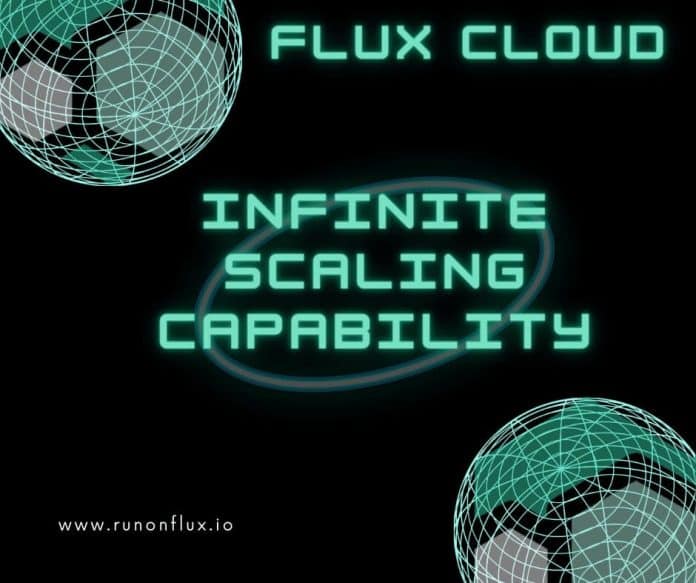Happy Hosts Scotland Ltd is on a mission to scale decentralised web3 + crypto infrastructure across Scotland. This is a great breakdown of What Flux Is and I had to share it.
Thanks to Happy Hosts Scotland for letting me share this content and also Ryan Matta, with permission I will be sharing some of the best content around Web 3. So if you would like to feature contact me.
Introduction
Last year we launched our Scotspot® Flux offering: giving ordinary people the chance to host Flux nodes in their home without spending a penny (unless they want to stake of course).
This year we have just launched our affiliate partnership with Seeed Studio enabling people from across the globe to purchase their very own preconfigured Flux node directly from Seeed themselves, scaling our impact from Scotland to the world.
To help you understand why we have chosen Flux to be a core part of our business model, and why we think it is possibly the most undervalued sleeping giant of web3, we wanted to share some thoughts.
We’re not going to go into depth of what Flux is, you can read that for yourself at the Flux website.
What we will do is approach this from a business perspective. In addition to founding Happy Hosts Scotland Ltd, our founder, Andrew McQuarrie, has over a decade of experience in enterprise grade IT with one of the oldest and largest IT companies in the world. Those 2 things combined let us consider Flux both from a startup + enterprise level perspective.
Why we back Flux
At Happy Hosts Scotland Ltd we have 3 core principles we use for all our decisions:
- Value – any project we invest in has to have real world value. What does this mean? In the corporate world it means it: has a business case (solves a problem that people will pay for) and it will ROI (return profits on the investment). Flux does this, both for it’s customers and it’s operators.
- Decentralisation – any project we support has to have a mission to be decentralised. This is the foundation of web3 and fundamental to the ownership of the internet + data by more people. Flux is the leading web3 cloud infrastructure company in the world and at it’s core is fully decentralised.
- Transparency – we believe in honesty + transparency. We need to be able to trust a project to invest. This relies on transparency. With Flux the whole team are available and ready to help and without asking they are constantly providing updates and insights into what’s happening and future roadmap items. Flux is the most transparent web3 project we’ve researched to date and we’re confident the team will deliver.
The mechanics + brilliance of the model
Flux is built on a 50% PoW (GPU Mining) + 50% Node model. This means rewards are distributed 50% to miners and 50% to node operators.
POW
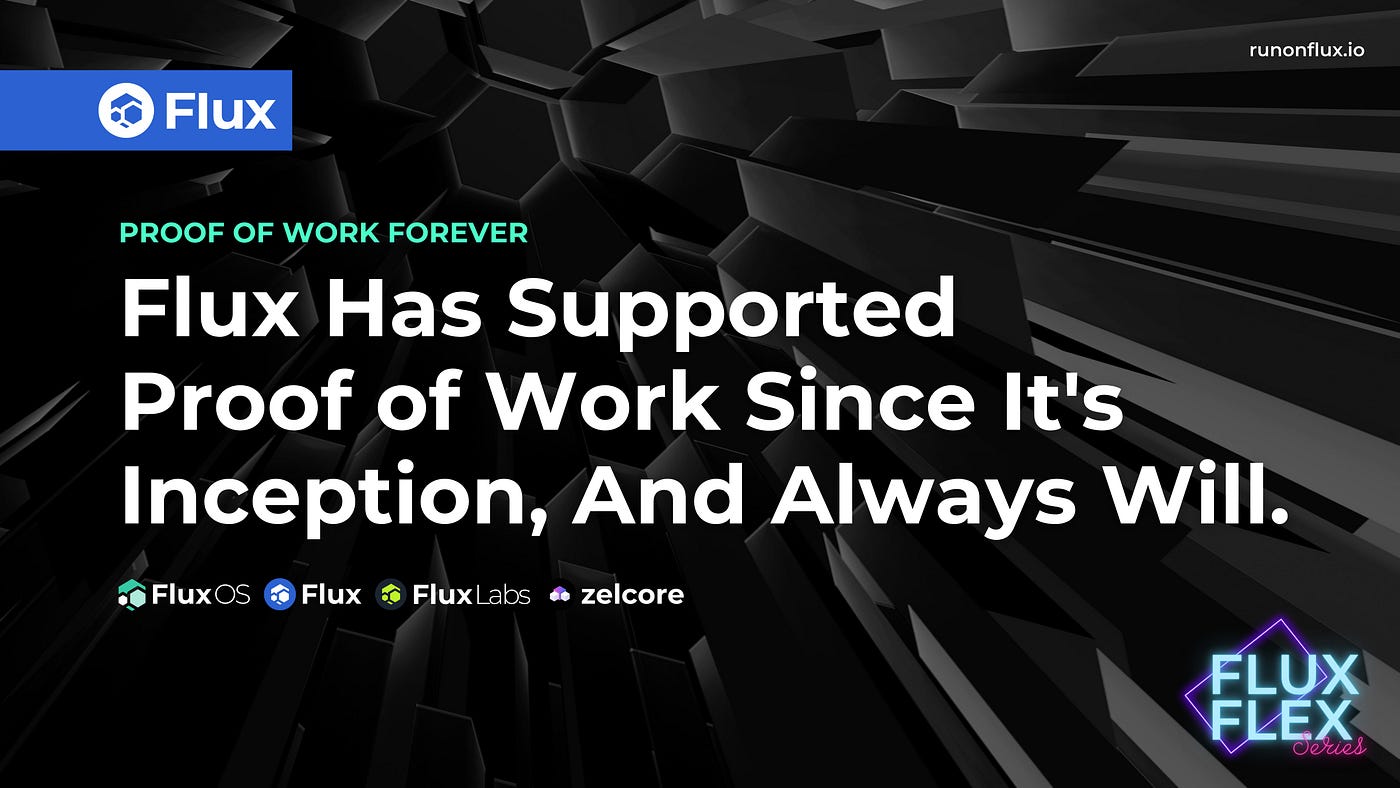
The Flux PoW algorithm is ASIC resistant which encourages miners to invest in multi-functional equipment in the form of GPUs. The algorithm also supports several legacy cards that would no longer be used in high-spec gaming PCs which, in theory, prolongs the usable life of those cards and reduces tech waste (big tick from a sustainability + cost of entry standpoint). They are also exploring proof of useful work (PoUW) – more on that in a moment.
Nodes

On the Node side they currently (at the time of writing – things are moving real fast!) have 3 tiers of nodes (Cumulus, Nimbus, Stratos) + a pure staking option (Titan). You can see the live economics here.
This allows various levels of participation. The key here is anyone with a decent internet connection can get involved. If you have a 25Mbps upload speed, then you can probably host a node, at home. If you can’t hit the benchmark requirement you can stake via Titan, where multiple people stake onto a Titan node for a fixed duration with fixed rewards.
The Stratos tier (which runs the Titan staking too) is essentially enterprise grade nodes where, to hit benchmarks, you’d be looking at professional level networking and compute power. This doesn’t mean large scale data centres (that wouldn’t be very decentralised) but it does mean it needs professional level investment (+ skills) to make it happen.
What makes the node model brilliant is that the capital investment in hardware is made by the community of node operators. So unlike the big cloud players, Flux have an advantage of virtually no CapEx for the compute power or networking equipment itself. This is where web3 changes the game, the people own the network.
PoUW
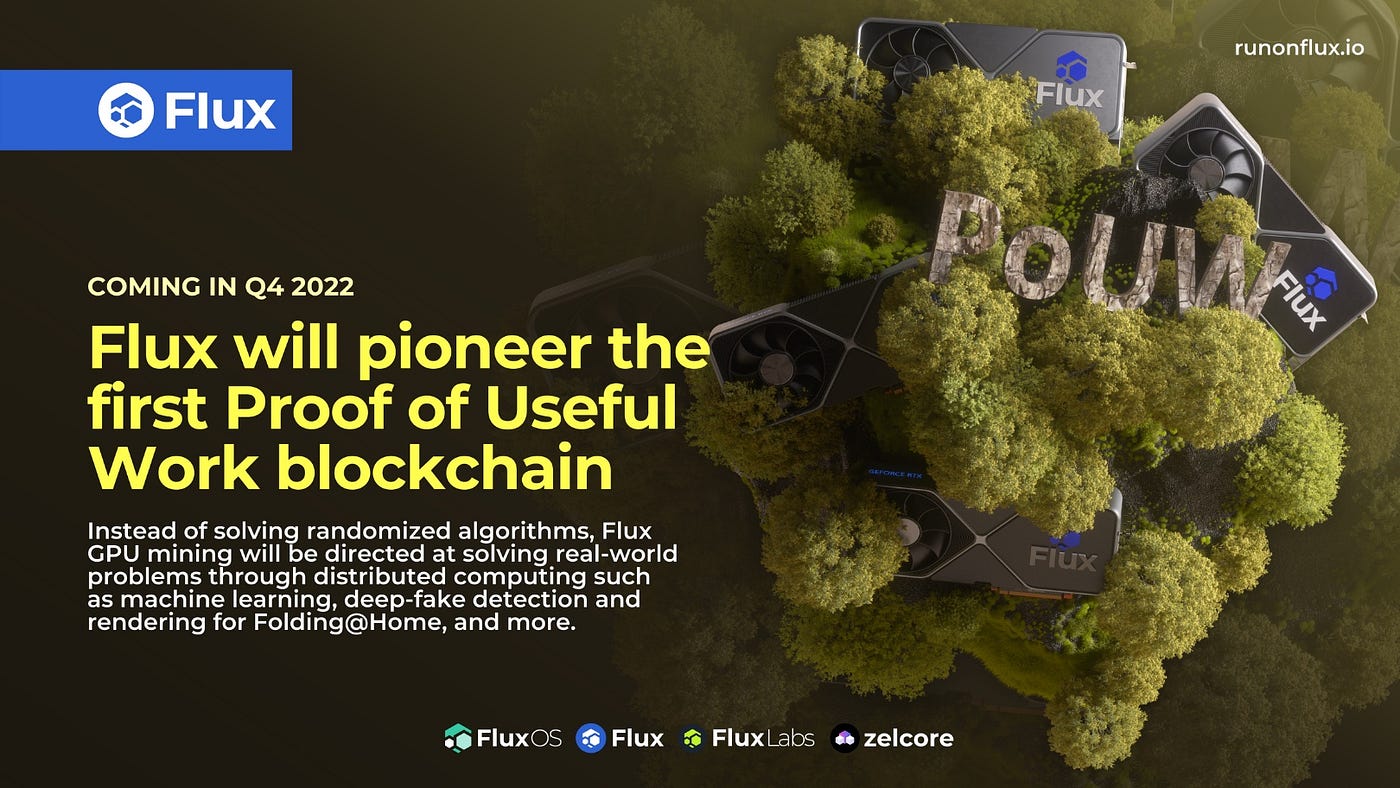
Proof of useful work is yet to be announced. The initial concepts are due to be announced shortly. Right now, from what has been said so far, PoUW will unlock idle resources further. Instead of hardware being used purely for blockchain validation, PoUW will allow task level allocation of resources – matching task requirements to available hardware.
This is a ground breaking evolution of PoW to optimise compute resources and further extend the useful life of hardware. Watch this space!
+ the hidden bonus
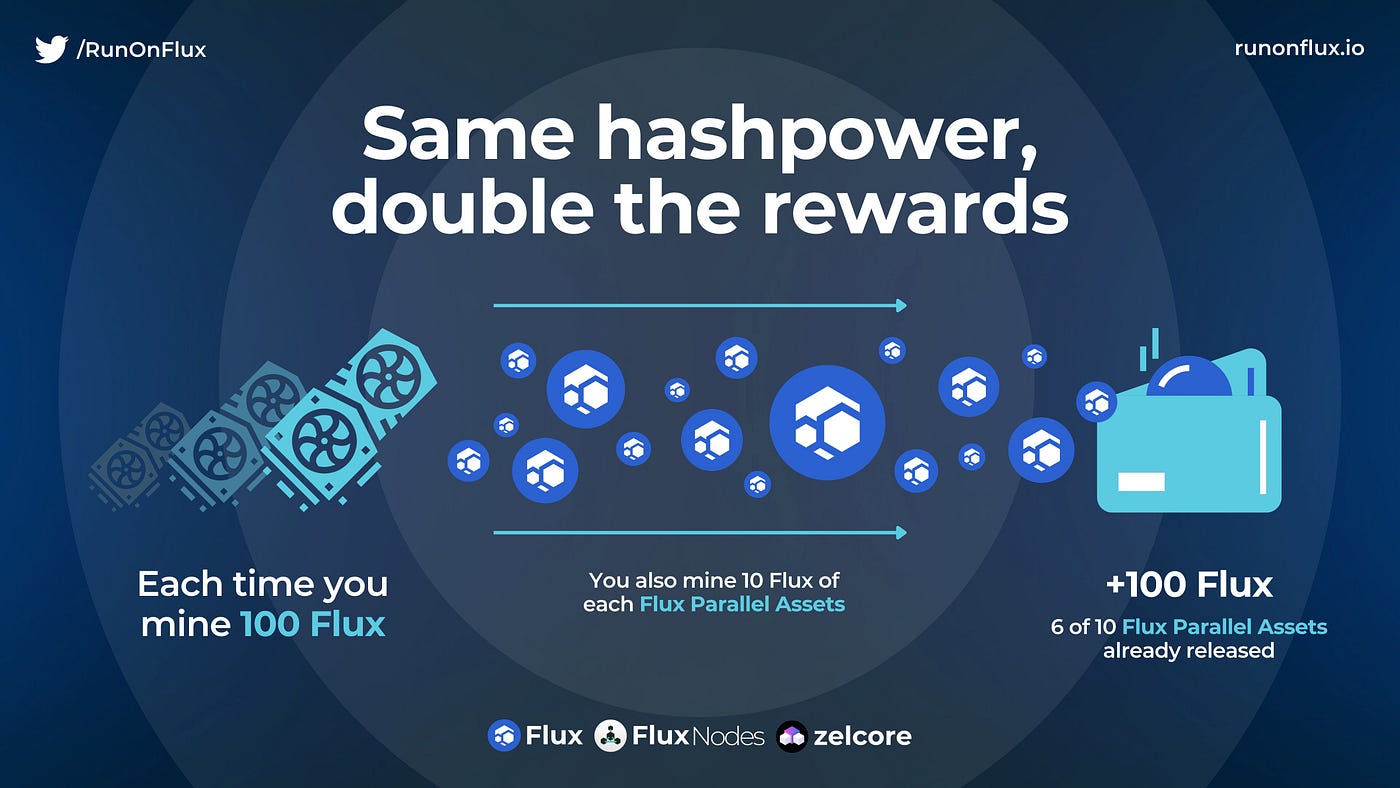
Flux has a concept of Parallel Assets (PAs). All network participants, on top of earning Flux for their services, earn PAs. These are essentially wrapped Flux from other blockchains which Flux has integrated with to provide a fully multi-chain ecosystem. This takes Flux from an average earner to one of the most profitable projects to operate in.
So what?
Why does all of that matter? It matters because Flux have managed to target multiple markets by sticking to their core mission:
Enterprise grade
Flux is building enterprise grade cloud services that are:
- Lower cost (by a huge margin)
- More resilient
- Hyper scalable
Consumer grade
Flux is building consumer features into their enterprise grade cloud services that are:
- Lower cost (by a huge margin)
- More resilient
- Hyper scalable
Investor grade
Flux is building business/investment grade rewards into their enterprise grade cloud services that are:
- Lower cost (by a huge margin)
- More resilient
- Hyper scalable
Web2
Flux has built enterprise level integration between Web2 and Web3 as part of their enterprise grade cloud services that are:
- Lower cost (by a huge margin)
- More resilient
- Hyper scalable
How will it be used?
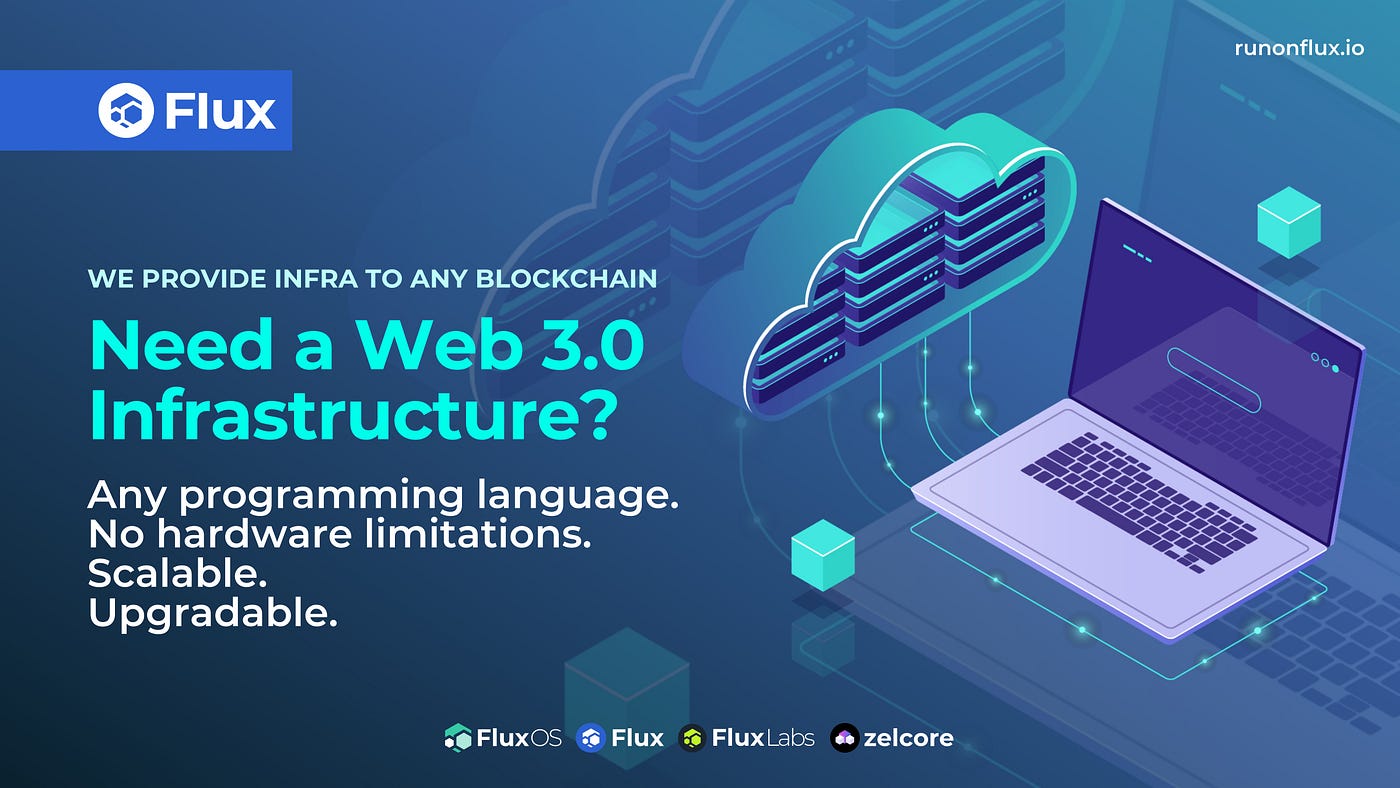
What the future holds for Flux beyond the existing roadmap is an unknown. As with all web3 projects there could be new offerings and models that we can’t even imagine today. However, at it’s core, based on the offerings we know about today, Flux will be used in the following ways:
Purely Decentralised Applications
dApps of all types can be run on Flux – at the moment they just need to be containerised using Docker. An ever growing list of web3 projects are choosing to run on Flux to avoid the centralisation of Web2 cloud services.
Hybrid Decentralised Applications
Some apps are choosing to compliment their core cloud services with Flux in a hybrid model, where the Flux infrastructure allows them low cost centralisation to compliment their existing infrastructure.
High Availability (HA) + Disaster Recovery (DR)
Key to enterprise customers is high availability (the ability to handle traffic without outages) and disaster recovery (the ability to get back online fast if disaster strikes). Any business where web services are a core part of their business processes (that’s almost every business these days) need to have both.
High Availability – In traditional IT (web2 world) this usually means paying huge sums of money to have multiple data centres live and synced with global load balancers managing traffic optimisation. If one data centre goes down there will be at least one more already running to pick up that traffic.
Disaster Recovery – In the unlikely event that disaster strikes and there is a global outage of services, disaster recovery is where offline servers + database backups can be brought online to recover business processes with minimal loses.
Flux gives enterprises HA as standard – with minimum spec services you already get 3 nodes. For larger scale businesses this can be customised to suit your needs at a fraction of the cost of traditional web2 cloud provides. Plus with truly decentralised nodes + data (IPFS) the risk of ‘disaster’ is mitigated to the point where the likelihood of a full scale outage is almost non-existent and recovery times will beat web2 systems.
IPFS Data Storage
Flux uses IPFS – Interplanetary file system – which means data storage is also decentralised. There is full redundancy in data as it’s stored in many places at once, no more expensive backup services. It also means data access can be optimised based on the location of the requester. But possibly the most significant factor is that no central authority can block your access to your data (as has happened recently with some leading web2 cloud services).
Elastic Compute Power
With PoUW around the corner, customers will be able to increase/decrease the services they need based on the work that needs doing. Truly elastic cloud is coming! Pay for what you actually use when you need to use it… if that means huge super computer power for your science research that you’ll only use for 3 times over 6months – that’s fine.
WordPress Hosting
Possibly the most significant though is WordPress hosting, a key market category in it’s own right (in 2022 over 43% of websites in the world use WordPress). Flux are just about to release full BETA testing for WordPress on Flux. Yes that means anyone will be able to put their WordPress site onto Web3, decentralised infrastructure, across 3 nodes, globally or geolocated, for a fraction of what you pay for hosting today.
We will even be migrating our existing business website over to Flux this year.
How to get involved
Buy some Flux. You can buy Flux on many exchanges, the most popular being:
Stake some Flux. Flux can be staked through ZelCore and on CoinMetro.
Host a Flux node. If you want to host a Flux node, you can setup a Flux node at home yourself. If you want to buy a preconfigured Flux node (and support our Web3 family business – we get a 5% commission) you can through our affiliates link on our homepage.
Run a GPU mining rig. If you want to put your old GPUs to work, you can setup a GPU mining rig and point it to one of the many Flux mining pools (we use https://fluxpools.net).
Spread the word. If you’re less interested in the token + tech and just want to support a great project checkout some of the community members below on social channels and spread the word!

